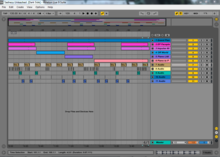Ableton Live
[4] Ableton has also made a fourth version of Live, Lite, with similar limitations to Intro, which is only available bundled with a range of music production hardware, including MIDI controllers and audio interfaces.
Henke and Behles identified a need in Berlin's electronic music scene for user-friendly software for live performances, and worked with local acts to develop it.
[7] Henke said later of Live's creation, "I think the feeling we had was [that] there was enough like-minded people in our closer community who could appreciate a product like this, and that it could work commercially.
[6] Roggendorf, another programmer, joined Behles and Henke in the late 90s and helped them turn their Max patches into a general set of software for retail.
[7] It offered sophisticated tools for triggering loops, playing samples and time stretching audio, and was immediately popular with electronic music producers.
[7] Live's time stretching algorithm, known as "Warping", was particularly notable and gave DJs greater control over mixing and beatmatching, smoothly blending tracks of different tempos.
[7] In 2004, Live expanded to become a DAW with a MIDI sequencer and support for virtual studio technology (VST).
Arrangement View offers a horizontal music production timeline of Clips that is more similar to a traditional software sequencer interface.
Ableton also offers a selection of Add-on Sample Packs with which a user can expand the sound libraries for their instruments.
They are tailored to suit Live's target audience – electronic musicians and DJs - but may also be used for other recording tasks such as processing a guitar rig.
This makes it possible for Live to shift these samples to fit into loops that are tied into the piece's global tempo.
The most obvious examples are volume and track panning, but envelopes are also used in Live to control parameters of audio devices such as the root note of a resonator or a filter's cutoff frequency.



